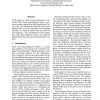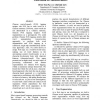168 search results - page 3 / 34 » Chinese Segmentation Disambiguation |
COLING
2002
13 years 5 months ago
2002
In this paper we report on our experiments on automatic Word Sense Disambiguation using a maximum entropy approach for both English and Chinese verbs. We compare the difficulty of...
EMNLP
2004
13 years 7 months ago
2004
Chinese part-of-speech (POS) tagging assigns one POS tag to each word in a Chinese sentence. However, since words are not demarcated in a Chinese sentence, Chinese POS tagging req...
ICMCS
2007
IEEE
14 years 3 days ago
2007
IEEE
Linguistic steganography, as a method of text steganography, is becoming a hot spot. To investigate the linguistic steganography for Chinese text, A Chinese linguistic steganograp...
TREC
2000
13 years 7 months ago
2000
In TREC-9, we participated in the English-Chinese Cross-Language Information Retrieval (CLIR) track. Our work involved two aspects: finding good methods for Chinese IR, and findin...
ACL
2003
13 years 7 months ago
2003
A central problem of word sense disambiguation (WSD) is the lack of manually sense-tagged data required for supervised learning. In this paper, we evaluate an approach to automati...


